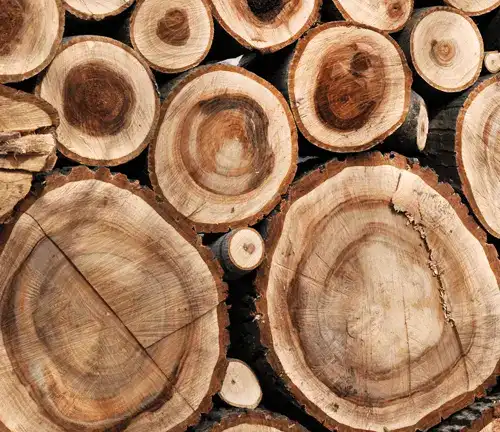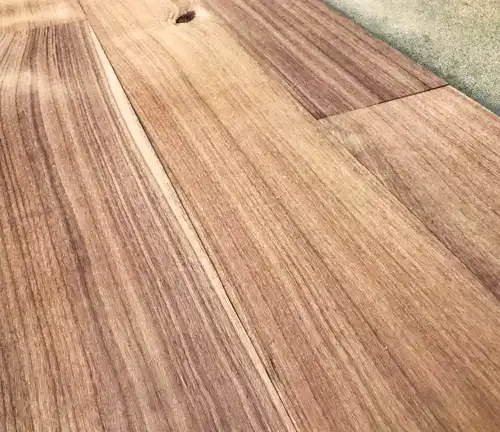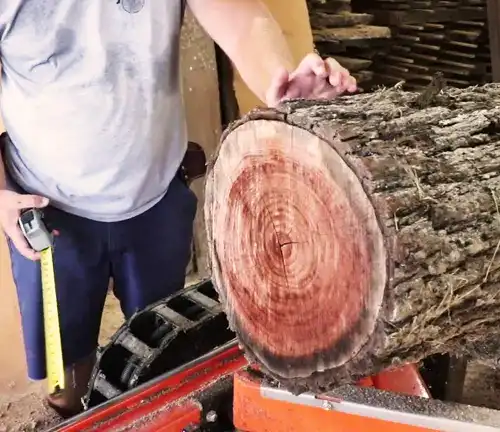Walnut Lumber
- October 6, 2023
- 0 comment
Walnut lumber is esteemed not only for its visual appeal but also for its unique working properties. The wood is known for being relatively easy to work with hand and machine tools, making it a favorite among craftsmen and woodworkers. Its consistency allows for precise cutting, carving, and shaping, which is crucial for creating intricate designs and fine details in furniture and other wooden items.

One distinctive feature of walnut lumber is its ability to take on a stunning finish. The wood has a natural luster that, when polished, enhances its deep, dark tones, creating a luxurious and sophisticated appearance. This makes walnut particularly popular for crafting high-end furniture pieces where aesthetics are as important as functionality. In addition to its visual and working attributes, walnut lumber possesses impressive stability.
It has a moderate level of movement in response to changes in humidity and temperature, which means that, when properly dried and seasoned, it is less prone to warping or twisting. This stability contributes to the longevity of items made from walnut wood, making them reliable and durable over time.
The natural resistance of walnut to decay and insects is another key factor in its desirability. This inherent durability means that walnut products often require minimal maintenance and retain their quality even in challenging environments.
While the cost of walnut lumber tends to be higher compared to other hardwoods, many enthusiasts and artisans find it to be a worthwhile investment due to its unparalleled combination of beauty, workability, and durability. Whether used in creating heirloom furniture or adding an elegant touch to interior spaces, walnut lumber stands as a testament to nature’s artistry and the craftsmanship of those who work with this exceptional material.
| Specification | Description |
| Density | 42-46 lbs/ft³ (672-737 kg/m³) |
| Hardness | Janka: 1,010 lbf (4,490 N) |
| Modulus of rupture | 14,600 psi (100.7 MPa) |
| Modulus of elasticity | 1,680,000 psi (11.59 GPa) |
| Compressive strength | 7,580 psi (52.3 MPa) |
| Moisture content | 6-12% |
| Color | Dark brown to chocolate brown, with a purplish hue |
| Specific gravity | 0.61 |
| Grain | Straight to wavy |
| Texture | Fine to medium |
| Shrinkage | Radial: 5.5% Tangential: 7.8% Volumetric: 12.8% |
Brief History

Walnut’s history in woodworking can be traced back centuries. During the Renaissance period in Europe, it was a favored choice among master craftsmen and artists. The wood’s rich color and luxurious grain made it highly sought after for creating ornate carvings, intricate furniture, and exquisite musical instruments. Its popularity persisted through various historical periods and continues today as a symbol of timeless elegance in woodworking.
Color/Appearance
Walnut lumber’s coloration is nothing short of captivating. Its deep, dark brown tones, often likened to the color of chocolate, are a testament to its natural beauty. The stark contrast between the heartwood and sapwood adds visual depth to the wood, making it a versatile choice for both traditional and contemporary designs. This distinctive color makes walnut a favorite among interior designers and furniture makers looking to create pieces that exude warmth and sophistication.

Grain/Texture

Walnut’s grain pattern is typically straight, offering a classic and clean look. However, what sets it apart are the occasional wavy or curly grain patterns that can appear, adding a touch of uniqueness and character to the wood. Its moderately fine texture is prized for its workability, allowing artisans to create smooth surfaces and intricate details. Whether you’re crafting a sleek modern table or a finely carved heirloom, walnut’s grain and texture provide endless design possibilities.
Unique Features
Walnut lumber stands out not only for its visual appeal but also for its structural qualities. While it may not be the hardest hardwood available, it strikes a balance between hardness and workability. Its stability and resistance to warping and shrinking make it an ideal choice for items that need to withstand the test of time. Additionally, walnut’s natural oils contribute to its resistance to decay and pests, reducing the need for chemical treatments and enhancing its eco-friendliness.
Pros and Cons
Pros
- Beautiful appearance with rich, dark color.
- Easy workability with both hand and machine tools.
- Stable and resistant to decay.
- Good finishing properties, takes stains well.
- Desirable grain patterns, adding character.
Cons
- Higher cost compared to some hardwoods.
- Not as hard, may be prone to dents and scratches.
- Color variation between sapwood and heartwood.
- Limited availability of large, clear boards.
- Darkens over time when exposed to light.
Workability
Woodworkers hold walnut in high regard for its exceptional workability. It can be easily cut, shaped, and sanded, allowing for precision and creativity in crafting. Its ability to hold screws and nails securely ensures structural integrity in joinery work. Whether you’re carving intricate details or creating clean, modern lines, walnut’s workability makes it a pleasure to work with for artisans of all skill levels.

Challenges in Working with Walnut
While walnut is generally praised for its workability, it’s essential to note that its natural oils can pose challenges during finishing. Some woodworkers may find that certain finishes react differently with walnut, requiring careful consideration and experimentation. Additionally, the hardness of walnut can vary, impacting the ease of cutting and carving, and woodworkers may need to adapt their techniques accordingly.
Native Distribution
Walnut lumber is sourced primarily from two species: Black Walnut, native to the eastern and central United States, and English Walnut, originally found in Central Asia. Black Walnut thrives in the temperate climates of states like Ohio and Indiana, while English Walnut is native to regions of Iran and Central Asia. These species have distinct characteristics shaped by their natural habitats. Despite their origins, both types of walnut trees have been widely cultivated globally, adapting to various climates. The demand for walnut lumber has thus expanded its cultivation, creating a global availability of this prized hardwood. The native distribution of walnut lumber highlights the intersection of ecological adaptation and human cultivation practices over time.

Sustainability
As sustainability becomes increasingly important in the lumber industry, efforts to responsibly harvest and manage walnut forests are growing. Sustainable practices ensure that walnut remains available for future generations while protecting the ecosystems it thrives in. This commitment to sustainability is crucial for preserving the long-term availability of this prized wood.

Availability and Cost
American black walnut is the most readily available variety of walnut lumber, especially in North America. However, European walnut, with its unique qualities, is often considered a luxury wood and may command a higher price. The cost of walnut lumber can be relatively high compared to other hardwoods, reflecting its desirability and limited supply.
Common Uses

Walnut lumber finds its way into a wide array of products, from classic and contemporary furniture to high-end cabinetry, elegant flooring, gunstocks, and musical instruments. Its ability to add a touch of sophistication and timelessness to any project makes it a top choice for discerning craftsmen and designers. Its natural beauty and versatility ensure its place in both functional and decorative woodworking.

Common Types of Walnut Lumber
English Walnut Lumber (Juglans regia)
Known for its elegance, English Walnut has a light to dark chocolate color with a straight grain and fine texture. It’s a preferred choice for high-end furniture, cabinetry, veneer, and gunstocks.
Black Walnut Lumber (Juglans nigra)
Characterized by a dark brown to purplish-black heartwood, Black Walnut has a straight or wavy grain and fine texture. Highly valued for its rich color and is commonly used in premium woodworking projects like furniture, cabinets, and gunstocks.
Persian Walnut Lumber (Juglans regia)
A variety of English Walnut, and Persian Walnut shares similar characteristics with a light to dark chocolate color. It is utilized in fine woodworking, furniture, and veneer projects.
Colombian Walnut Lumber (Juglans neotropica)
Native to South America, Colombian Walnut exhibits a range of colors from light to dark brown. It’s valued for its appearance in fine woodworking and furniture making.
Japanese Manchurian Walnut Lumber (Juglans mandshurica)
Native to East Asia, Japanese Manchurian Walnut has a light to medium brown color. It finds use in woodworking and furniture making in its native regions.
Northern California Claro Walnut Lumber (Juglans hindsii)
A type of Claro Walnut native to northern California, it is known for its intricate figure patterns. Highly sought after for high-end furniture and decorative veneers due to its unique grain patterns.
Frequently Asked Questions (FAQs)
- Can walnut lumber be sustainably sourced?
Yes, many suppliers offer walnut lumber that comes from sustainably managed forests. Look for certifications such as FSC (Forest Stewardship Council) to ensure the wood is harvested responsibly. - Does the color of walnut lumber change over time?
Yes, the color of walnut lumber tends to darken over time due to exposure to light. This natural aging process enhances the richness of the wood, and many woodworkers appreciate the patina that develops. - Is there a significant price difference between heartwood and sapwood in walnut lumber?
Yes, heartwood, which is the darker, inner part of the walnut tree, is generally more expensive than sapwood. Heartwood is prized for its rich color and is often preferred for high-end furniture and woodworking projects. - How does walnut lumber react to different finishes?
Walnut lumber is known for its excellent finishing properties. It accepts a variety of finishes, including oils, stains, and clear coats, producing a smooth and lustrous surface. Testing finishes on a small, inconspicuous area is recommended to achieve the desired result. - Are there any special considerations when working with walnut lumber for outdoor projects?
While walnut is a durable wood, it is not typically recommended for outdoor use. If used outdoors, it should be adequately sealed and protected from the elements. Outdoor projects are generally better suited to woods known for their natural resistance to decay, such as teak or cedar.
Walnut Lumber is more than just a material; it’s a testament to craftsmanship, history, and nature’s enduring beauty. Its rich history, exceptional characteristics, and enduring appeal make it a prized resource in the world of woodworking. As sustainability practices continue to evolve, walnut lumber’s future remains bright, ensuring its continued prominence in the world of fine woodworking.







Leave your comment